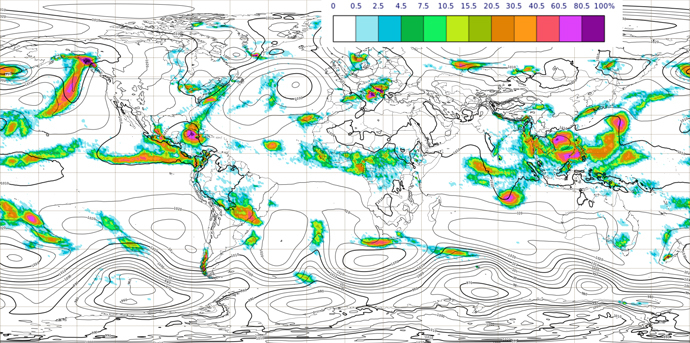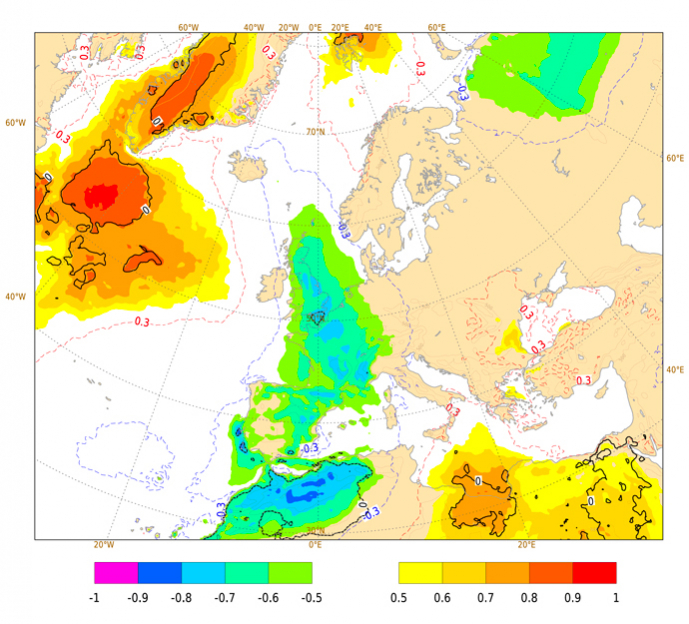

ECMWF was one of the first centres to introduce operational ensemble forecasts, a move which 30 years ago initiated a distinct shift in thinking. Today, ensembles are at the core of ECMWF’s forecasts across the medium, extended (monthly) and long (seasonal) range and they support a range of environmental services.
The chaotic nature of the atmosphere means that no weather forecasting system can ever be perfect and there will always be uncertainties. An ensemble (or group) of forecasts attempts to encompass this uncertainty and provides a range of possible outcomes and the likelihood of, for example, hazardous weather or extremes.
We have seen the skill of our forecasts increase significantly over time, and today our forecasting system is recognised as one of the best in the world. This progress relies on work to improve our Earth system model, the use of ever finer resolution, and improvements in the forecast initial conditions, through advances in data assimilation and the use of an increasing range of weather observations. Developments in supercomputing are also crucial. Such progress is only possible through extensive collaboration with our Member and Co-operating States, academia, and industry.

An example of an ECMWF forecast chart that looks four days ahead. Colours denote the probability in percent, for 26 September 2022, of a ‘wet day’ – defined here to be rainfall exceeding 25 mm in a 24-hour window. Black lines denote the ensemble mean value of mean sea-level pressure, in hPa, which relates to the rainfall patterns.
A brief history of ensemble forecasting at ECMWF
1980s – investigating ensemble forecasting
It was known from the early days of numerical weather prediction (NWP) that some forecasts can be skilful for longer forecast ranges, while others go badly wrong within just one or two days. This is because small uncertainties, in the model equations and in the observations used to determine the initial conditions, can grow rapidly when the atmosphere is in an unpredictable state. It was eventually realised that even simple chaotic systems had this property – that is to say, day-to-day variations in skill are an inevitable consequence of the chaotic nature of the atmosphere. Ensemble prediction attempts to estimate ahead of time when the atmosphere is predictable and when it is not. This can provide forecast users with vital information about likely forecast skill.
When operational forecasts began at ECMWF in 1979, they were based on a single forecast, and various techniques were investigated to try to predict ‘forecast skill’. It became clear that using ensembles was the only feasible way to do this.
With an ensemble of forecasts, each starting from slightly different initial conditions and encompassing model uncertainties, the spread of outcomes gives a measure of predictability and forecast confidence. Ensemble forecasts are often referred to as probabilistic.
Professor Tim Palmer, who had a leading role in the development of ensemble forecasts at ECMWF, describes a personal ‘eureka moment’ in the mid-1980s, when, inspired by the work he was doing at the UK Met Office to develop ensemble forecasts at monthly timescales, he realised that ensembles should also be beneficial for short and medium-range forecasting.
A key challenge in developing a reliable and accurate operational ensemble prediction system was (and continues to be) how best to represent the uncertainties in the initial conditions and forecast model. Based on several years of research, ECMWF developed a technique using singular vectors to calculate small adjustments to the initial conditions which helped to effectively maximise the spread of ensemble members. Singular vectors are still used in ECMWF operations today. Other forecasting centres developed different approaches to generate their ensemble forecasts.
1990s – ensemble forecasts go live
In December 1992 operational ensemble forecasts began at ECMWF. They began at the US National Centers for Environmental Prediction at around the same time and were subsequently introduced at many other forecasting centres around the world.
ECMWF’s first ensemble forecasts had 33 members and a horizontal resolution of approximately 210 km. The forecasts ran three times a week, out to ten days ahead.
The numerical models used to simulate the atmosphere, ocean, and other Earth system components, also have uncertainties. In 1998 a technique was introduced into the ECMWF ensemble system to represent uncertainties in the atmospheric model. The Stochastically Perturbed Parametrization Tendencies (SPPT) scheme applies adjustments during the forecast to the model representation of sub-grid scale processes such as clouds. It has brought skill to the ensemble system ever since.
2000s and onwards – continual improvements in ensemble forecasts
Since the beginning of the 2000s, ensembles have also been used to generate ECMWF’s monthly and seasonal forecasts, run at a coarser resolution than the medium-range ensembles to limit production costs. Over time, we have continued to move ever closer to a ‘seamless’ forecasting approach with consistent forecasts across all timescales.
Ensembles were introduced into our data assimilation system in 2010 to represent uncertainties in the atmospheric initial conditions of our forecasts, in addition to the use of singular vectors. The ensemble of data assimilations (EDA) is produced by running the atmospheric data assimilation scheme multiple times, each with slightly adjusted observations and model parameters. The addition of EDA-based perturbations brought major improvements in forecast skill.
Ensembles are also used at ECMWF for our reanalyses: a blend of past observations and with short-range weather forecasts which provide the most complete picture possible of past weather and climate. When data from our ERA5 reanalysis were released in 2019, uncertainty information was included for the first time, based on the use of ensembles within our four-dimensional variational data assimilation (4D-Var) data assimilation system.
In May 2021, a change was introduced to the way numbers are stored in computer memory during our forecasts. For most model calculations, single precision (which uses 32 bits of computer memory) replaced double precision (which uses 64 bits). The change freed up about 40% of computing power to use for forecast improvements. One such improvement was an increase in the vertical resolution of ensemble forecasts from 91 levels to 137, which enhanced many aspects of our forecasts.
Over 30 years, the resolution of our medium-range ensembles has increased from 210 to 18 km, and there have been continuous advances in our Earth system model, data assimilation system and use of observations. We have seen the lead time of our skilful ensemble predictions increase by about one and a half days per decade on average (see figure below), and ensembles are now used across our entire forecasting system.

The skill of ECMWF ensemble forecasts has increased significantly over 30 years of operational use.
The graph shows the number of days into the future that the ensemble system provides useful forecasts of 850 hPa temperature for the northern hemisphere extratropics and how this has evolved over time. ‘Useful’ is defined by a particular global verification metric (the continuous ranked probability skill score (CRPSS)) reaching a certain level (25%). A CRPSS score of 100% represents a perfect forecast, while 0% represents a system with no skill (compared with using long-term average conditions).
The value of ensemble forecasts for decision-making
A whole range of products has been developed to help users interpret ensemble forecasts for their particular application. Products are designed to show succinctly the range of potential outcomes and to present probability-based information – across the medium-, extended- and long-range timescales.
The probabilistic information that ensembles provide can be particularly valuable for early warnings of hazardous weather, which can help guide action ahead of an event. For example, to trigger the deployment of humanitarian aid in advance of a potential hurricane or flooding event.
The Extreme Forecast Index (EFI) was introduced operationally around 2002 to provide users with information about the chance of extreme conditions or severe weather such as heavy rain, extreme temperatures or high winds.

Colours show the Extreme Forecast Index for 27 September 2022, for daily mean 2 m temperature, from a forecast time of 00 UTC on 22 September (so 6 days into the future). This highlights, for example, that unusually cold conditions (for the time of year) are predicted to affect western Europe and northwest Africa. Black contours show the ‘Shift of Tails’ index – a complementary measure that highlights how extreme the event could actually be (larger values mean more extreme). Both indices are based on comparing ensemble forecasts with re-forecasts of the past climate.
We also provide ensemble-based forecasts of tropical and extratropical storms; for example, the forecast probability that a storm will hit a particular location.

Forecast tracks of the exceptional category 4 tropical cyclone Ida, that made landfall in Louisiana, US, in 2021, in the ECMWF high-resolution (solid line) and ensemble (dotted line) forecasts. Track strike probabilities from the ensemble are shown by colours. The forecast initialisation time corresponds to when Ida was first formally identified as a tropical cyclone: it starts out in the Caribbean, then moves north-westwards towards the US.
Many other ensemble-based forecast products are available, in addition to products from our high-resolution forecast.
The future of ensemble forecasting
Since ensemble forecasts began at ECMWF, they have been run at a lower resolution than the single 10-day forecast. This will change in 2023, when the resolution of the medium-range ensemble forecasts will double from a grid spacing of 18 to 9 km – our 15-day ensemble and single 10-day forecast will be run at the same resolution. This is a really significant step forward, made possible with the power of our new Atos supercomputing facility in Bologna, Italy. The extended-range forecast is also increasing from 51 to 101 ensemble members, running at a horizontal resolution of 36 km from day 1 to day 46.
Machine learning and other forms of artificial intelligence (AI) could play a major in role in ensemble predictions and NWP in general. AI can help to significantly increase the efficiency of numerical models, particularly as data volumes increase rapidly at ever finer model resolution. AI could, for example, help to enhance local-scale predictions.
Taking horizontal resolution down to kilometre scale is a key objective. It will allow Earth system models to begin resolving deep convection and some other sub-grid scale processes. Global ensembles at such convection-permitting resolutions are important for ECMWF’s goal to predict high-impact weather two weeks ahead. Recent single realisation experiments at 4.5 and 2.8 km show marked improvements in predictions of tropical cyclone intensity, for example, but there are many challenges before such resolutions will be operational.
As climate change becomes even more pronounced and extreme weather events more severe, it is becoming increasingly urgent to monitor and forecast such events and their impacts across society. By providing risk-based information to help prepare in advance of such events, ensemble weather forecasting has an important role in helping the world adapt to the effects of climate change.
The EU Destination Earth programme, in which ECMWF is playing a key role, is one initiative leading the way. The programme is creating digital twins of the Earth system to support climate change adaptation policies and decision-making for reducing the impacts of extremes. It is a pillar for the EU’s Green Deal Strategy to protect the environment and curb greenhouse gas emissions.
Clearly, ensemble forecasting is set to continue its pivotal role in weather forecasting, in managing risks from hazardous weather and for disaster preparedness, as well as contributing to addressing climate change and other environmental pressures across Europe and worldwide.
Symposium to mark 30 years of ensembles and the career of Tim Palmer
On 5 and 6 December 2022, ECMWF and the University of Oxford will hold a symposium to mark the 30th anniversary of operational medium-range ensemble forecasts at ECMWF and the career of Tim Palmer. Talks will be livestreamed and publicly available.
